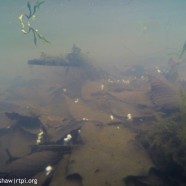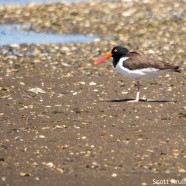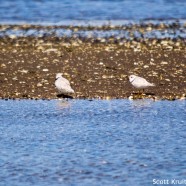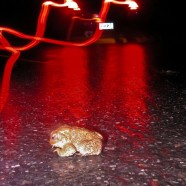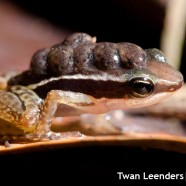Underwater World
While these little white puffs may look like little air pockets escaping from underwater volcanoes they are actually little spermatophores, or sperm packets produced by male spotted salamanders (Ambystoma maculatum), scattered across a vernal pool floor. As females arrive and enter ephemeral pools (sometimes up to a week after the males), males go into a frenzy. Typically the ratio of males to females in the pools is very skewed, with many males to every one female. This fuels some pretty intense male to male competition and very interesting sexual selection. Males surround females and nudge...
Read MoreAmerican Oystercatchers Relaxing
American Oystercatchers have been pairing off across Connecticut, and a few sites and birds have been reported as copulating. However, like the Piping Plover, we still have no confirmed nests likely because of the continuing cold conditions at times. With the warm-up of the last few days and late April coming there will be eggs soon. Until then these birds were relaxing on the beach out of the wind and tucking in their bills for a midday nap.
Read MoreSlow Piping Plovers
This year has been rather cold – talk about news you did not need to know, huh? Even though temperatures have been much closer to average in recent days there is still not a lot of action on the breeding birds front, with these distant looks at Piping Plovers feeding in the middle of a marsh on a chilly, windy morning yesterday showing they are not nesting yet. Nights with lows near freezing will keep eggs at bay for the moment, but we at the Audubon Alliance for Coastal Waterbirds continue to be extremely busy putting up fencing and signage, reporting migrants, recording pairs and...
Read MoreAmphibian Crossing
This Wednesday or Thursday, depending on your location in the Northeast, should bring temperatures well past 40 or even 50 with rainy conditions. Since it is late March it may be the first night of amphibian migration as these are ideal conditions for frogs, toads and salamanders to emerge from hibernation and start migrating to a nearby wetland at night! Please slow down for salamanders and frogs when you’re driving back roads near wetlands – even when they don’t get crushed by your tires, the slipstream generated underneath a vehicle when you’re moving more than 20-25 MPH will pick these...
Read MoreFrog Friday Parenting
Thank Goodness it’s Frog Friday again! Although every day is frog day in my book, I have to admit that I am particularly excited about next Frog Friday because I will be heading down to Panama again to expand our ongoing research on the endangered amphibians found in Cocobolo Nature Reserve. So many questions to answer… Why did some species survive the mass extinctions that ravaged other sites in Panama? How did selective decline of some species in the preserve affect the balance between surviving species? Are there ways to safely re-introduce some of the ex-situ backup...
Read More



